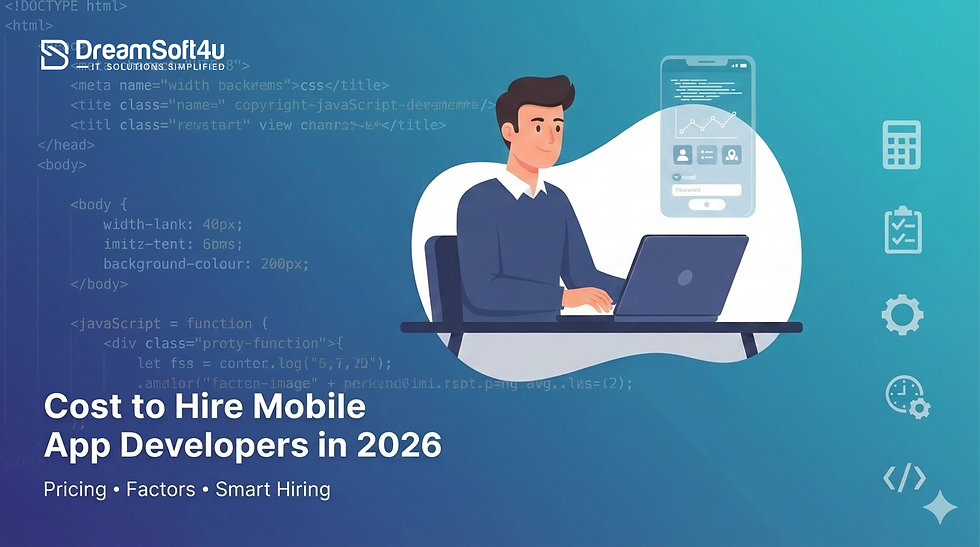Fitness App Development: A Complete Guide
- ds4useodigital
- Jul 16, 2024
- 3 min read
During the COVID, the health and fitness industry experienced a major shift from physical to online fitness. This is because the gyms were locked. Although the world has overcome the fear of coronavirus, fitness applications are still in full swing.
People who follow and practice a healthy lifestyle use fitness apps to keep track of their daily activities. Therefore, the fitness app development market is flourishing rapidly. If you are planning to enter the world of fitness app development, it is the best time to do so! Since the market is flooded with hundreds of fitness apps, setting your application ahead of the competition is difficult.
What are fitness applications?
Fitness applications are mobile apps which allow users to improve their fitness level easily! These applications come with different features and cater to all aspects of wellness and fitness. These include diet tracking, routine exercise and sleep monitoring. The primary aim of designing and building such applications is to provide users with an easy way to improve their wellness. This application suggests personalized workout plans and provides nutritional guidance.
Types of Fitness Apps
Here are different types of fitness applications:
1. Activity tracking applications
Activity tracking apps are a popular kind of fitness application that monitors your everyday physical activities. These include distance traveled and steps taken in a day. Some popular examples of activity-tracking apps are Fitbit and Garmin. These sync with your wearable devices to offer insights into everyday activity levels. They also provide data, allowing users to achieve their fitness goals in real-time.
2. Workout and training apps
Workout and training applications such as Nike training club provide users customized training routines based on their weight loss and muscle gain goals. These applications also offer tutorials and workout plans to achieve these goals faster and more efficiently.
3. Nutrition and diet apps
Users can now track their calorie intake and meal planning through the nutrition and diet application. Some popular applications are MyFitnessPal and Lose It!. These allow users to log their food consumption. These apps also offer detailed nutritional information and extensive databases of foods.
Top Features of a Fitness App
1. User registration and logins
With the help of this feature, users can make their own personal profiles and log in to the app with their chosen login details or with accounts from other social media sites, such as Facebook, Instagram, or email.
2. Activity tracking
It is a prime feature of the fitness applications that can be integrated seamlessly with wearable devices. You may easily monitor important user metrics such as Steps taken, heart rate, calories burned, distance traveled and active minutes. Accurate tracking allows users to track overall progress. Further, they can easily make important alterations to achieve their fitness and active lifestyle goals.
3. Nutrition plan and recipe database
Nutritional advice and food intake tracking should be included in a comprehensive health and fitness app. It should be possible for users to record their hydration levels, meals, and snacks. Furthermore, integrating with food item and recipe databases can help promote healthy eating practices and help achieve weight control objectives.
Top Benefits of Developing a Fitness Application?
1. Increased Motivation and Accountability
Features that keep users motivated and accountable include progress tracking and social sharing. A sense of accomplishment and community is fostered by virtual challenges, prizes, and support. It motivates users to stick with their exercise regimens. Visual progress tracking encourages positive behavior and increases motivation.
2. Market Demand and Revenue Potential
The fitness apps market is expanding because of rising health and wellness awareness. Creating a fitness app ensures you take advantage of this lucrative sector. It offers significant revenue possibilities through in-app purchases, subscription models, and advertising. Additionally, fitness apps can collaborate with fintech app development companies and goods to generate income.
3. Data Collection and Insights
Fitness applications are enriched with valuable data which provide insights into the user behavior and fitness trends. This information is used to enhance user experience and improve app features. Further, developers use this information to build highly engaging and interactive content. It ensures customer satisfaction and long-term user retention.
List the Cost of the Fitness App Development
The average cost of developing a quality fitness application ranges between $20,000 to $2,00,000. There are several factors based on which the prices keep fluctuating. Some common factors which determine the overall development cost are:
Fitness application development platform
Complexity of the application
Type of the fitness app
Experience and expertise of developers
Features and functionalities of the application
View Original Source - https://www.dreamsoft4u.com/blog/fitness-app-development









Comments